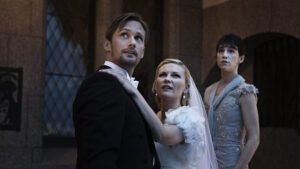Lars von Trier’s 2011 film, “Melancholia,” is a visually stunning and emotionally complex exploration of depression, family dynamics, and the impending doom of a rogue planet hurtling toward Earth. The film, divided into two distinct parts, delves into the contrasting reactions of two sisters, Justine (Kirsten Dunst) and Claire (Charlotte Gainsbourg), as they face the approaching apocalypse.
Part 1: A Frayed Tapestry of Familial Tensions
The film’s first part unfolds during Justine’s lavish wedding celebration at Claire’s sprawling estate—a sense of unease and underlying tension mar the festivities. Justine, recently separated from her fiancé, appears apathetic and withdrawn, starkly contrasting with Claire’s meticulous planning and optimistic demeanor. Their contrasting personalities and troubled relationship with their parents create a simmering pot of dysfunction.
As the newlyweds and their eccentric family gather, the impending arrival of Melancholia hangs heavy in the air. Astronomical reports and hushed conversations cast a shadow over the celebration. John (Kiefer Sutherland), Claire’s pragmatic husband, attempts to maintain normalcy, while Justine becomes increasingly withdrawn, grappling with a sense of impending doom.
Part 2: Facing the Inevitable
The second part occurs a few weeks later, with Melancholia looming large in the night sky. Justine has moved in with Claire and her family, seeking refuge from her anxieties. In stark contrast to Claire’s escalating panic, Justine seems strangely accepting of their fate.
As the planet draws closer, the family grapples with individual responses to the impending catastrophe. John desperately clings to hope, while Claire descends into despair. On the other hand, Justine finds a sense of peace and acceptance, embracing the inevitable.
A Symphony of Symbolism and Visual Poetry
“Melancholia” is a masterfully crafted film where symbolism and visual metaphors play a crucial role in conveying the emotional complexities of the narrative. The slow, deliberate camerawork and stark, minimalist landscapes create a sense of impending doom and emotional isolation. The recurring motif of the blue planet, Melancholia, serves not only as a literal threat but also as a symbol of the character’s inner turmoil and the melancholy undercurrent that permeates the film.
Von Trier’s signature use of slow-motion sequences and dreamlike imagery enhances the film’s emotional impact. The film’s haunting score further underscores the themes of despair, acceptance, and the fleeting beauty of existence in the face of destruction.

Beyond the Apocalypse: A Commentary on the Human Condition
While “Melancholia” utilizes the impending apocalypse as a central plot device, it focuses on exploring the human condition. The film delves into themes of depression, sibling rivalry, family dysfunction, and the search for meaning in the face of an indifferent universe.
The contrasting characters of Justine and Claire represent different ways of confronting existential anxieties. Justine’s acceptance may be interpreted as surrender, while Claire’s struggle reflects a human desire to cling to hope and fight for survival, even when faced with the inevitable.
A Controversial Yet Enduring Masterpiece
“Melancholia” divided audiences and critics upon its release, with some finding its bleak portrayal and ambiguous themes unsettling. However, the film’s undeniable artistic merit has earned it a place among modern cinematic masterpieces. “Melancholia” remains a thought-provoking and emotionally resonant exploration of human resilience, despair, and the search for meaning in a world teetering on the brink of oblivion.

